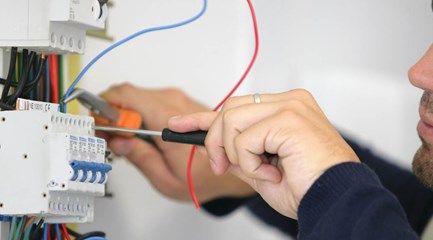Lockdown may seem like the perfect time to give your home a well needed fix-up with some DIY tips you probably found online. However these tips aren’t always the safest and could leave you with a bigger problem on your hands.
Almost half of all electric shocks described as severe are the result of a DIY error, so it’s important to know your limits when it comes to conducting over-ambitious works within your home. Not only this, but it could end up costing you more money than it’s worth since a botched DIY project could put you at risk of invalidating warranties and affect your ability to sell your home!
We have put together a list of tasks that can be done without professional help so long as the accompanying important tips for avoiding mistakes are followed.
So if you’re itching to give your home a little makeover, these are what we recommend:
Wiring a plug:
- Always buy your replacement plug from a reputable retailer that you know and trust, not a third party seller on an online marketplace.
- Check that the new plug meets British safety regulations. It should be marked with ‘BS 1363’ and a Notified Body approval mark, such as BSI’s ‘Kitemark’, the ASTA ‘Diamond’ mark or Nemko’s ‘N’ mark.
- Follow the wiring instructions provided by the plug manufacturer, which should be clear and accompany the product.
- If you have a foreign appliance, fit a conversion plug (which is not a travel adaptor) to connect a foreign appliance to the UK electricity supply. Do not replace its plug with a UK plug.
- WARNING: Replacing a plug with a non like for like could potentially invalidate your warranty so always ask the manufacturer if it is ok to do so before cutting it off or replacing it.
- WARNING: NEVER attempt to make your own extension lead or wire two plugs on each end of a length of cable to extend power.
Replacing a light bulb
- Always buy your bulb from a reputable retailer, not a third party seller on an online marketplace
- Make a note (or take photo) of the rating in watts and voltage of the bulb, and what type and size of connection (push fit or screw type)
- Switch off the light switch before removing or replacing the bulb – and if it’s on a two-way switch then turn the supply off at the fusebox (switch off the circuit-breaker or remove the fuse)
- WARNING: An incorrect wattage or volts, as well as the wrong type of lamp, can lead to overheating and potential fire, so ensure the details match the ones you’re replacing
Checking operation of an RCD
- An RCD is a sensitive safety device installed in the fusebox that switches off electricity automatically if there is a fault, preventing you from getting a fatal electric shock if you touch something live, such as a bare wire.
- To check if you have fixed RCD protection, go to your fusebox and have a look to see if there is a device with a pushbutton marked ‘T’ or ‘Test’.
- You should test all fixed and socket RCDs about every six months – do this by holding down the test button and waiting for the electricity supply to turn off
- WARNING: If you hold the test button in for a long time and the RCD does not switch off the electricity supply, then get advice from a registered electrician.
Before drilling a hole in your wall to nail a picture…
- Make sure you’re not about to drill through a cable, which could risk you getting a serious electric shock and the damage is very expensive to put right
- To do this, ensure there are no sockets or switches either vertically or horizontally aligned with the hole you’re about to drill
- WARNING: If you do damage a cable and the fuse blows or the circuit-breaker trips – don’t try to remove any screw/nail that might be left in – and don’t try to repair the damaged cable yourself. Instead, call in a registered electrician.
Installing plug-in garden lighting
- Concentrate on lighting the most attractive features of your garden rather than lighting everything in sight, and avoid positioning lights so that they shine into a neighbour’s window.
- Stick to LED lights over traditional filaments lights – they have a range of benefits including a significant reduction in electric shock risk, use 80-90% less electricity and are more durable.
- Always buy outdoor lighting equipment from a reputable retailer and ask them to confirm that it is suitable for outdoor use. The lighting equipment should carry an IP (ingress protection) rating, which indicates how well it stands up to external conditions – for outdoor use, the last number should be three or higher. Lights marked with a symbol should NOT be used outdoors.
- Ensure you use a socket that is also suitable for outdoor use and that it is an RCD type or RCD protected in your fusebox.
- WARNING: Some outdoor lights can get hot, so place out of reach of small children.
- WARNING: Only attempt plug-in lighting yourself – get a registered electrician in for anything more complex.
More posts by Samantha Mager



